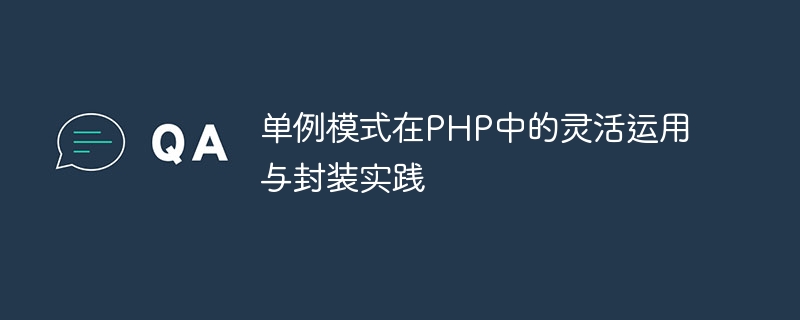Home >Backend Development >PHP Tutorial >Flexible application and encapsulation practice of singleton pattern in PHP
Flexible application and encapsulation practice of singleton pattern in PHP
- 王林Original
- 2023-10-15 14:45:111417browse

Flexible application and encapsulation practice of singleton pattern in PHP
Introduction:
The singleton pattern is a common design pattern used to ensure a A class can only create one instance and provide global access. In PHP, the singleton mode is very practical, especially when sharing resources, data caching, etc. are required. This article will introduce the application scenarios of the singleton pattern in PHP and provide detailed code examples.
1. What is the singleton pattern
The singleton pattern is a creational design pattern. Its core idea is to ensure that a class can only create one instance and provide a global access entrance. In the application, there are some classes that only require one instance, such as database connection, configuration information, cache, etc. Using the singleton pattern can easily manage instances of these classes and avoid repeated creation and waste of resources.
2. Application Scenarios of Singleton Mode
In PHP, the application scenarios of singleton mode are very wide, especially when sharing resources and data caching are required.
- Database connection: Usually an application only requires one database connection instance. Using the singleton mode can ensure that only one connection instance is created and reduce resource consumption.
- Configuration information: Configuration information is usually used frequently in applications. Using the singleton mode can encapsulate the reading and operation of configuration information to facilitate global access.
- Cache management: Caching is an important means to improve application performance. Using the singleton mode can facilitate the management and operation of cache and ensure the consistency and validity of data.
3. How to implement singleton mode
In PHP, there are many ways to implement singleton mode, the most common ones are to use static variables and static methods. The following takes a simple database connection example as an example to demonstrate the implementation of the singleton mode.
class DatabaseConnection
{
private static $instance = null;
private $connection;
private function __construct()
{
$this->connection = new PDO('mysql:host=localhost;dbname=test', 'root', 'password');
}
public static function getInstance()
{
if (self::$instance === null) {
self::$instance = new self();
}
return self::$instance;
}
public function getConnection()
{
return $this->connection;
}
}In the above example, the constructor of the DatabaseConnection class is defined as a private method to prevent external creation of object instances through the new operator. The getInstance method is responsible for creating or returning a unique instance. If the instance does not exist, create a new instance. If the instance already exists, return the existing instance directly.
It is very simple to use the singleton mode to obtain a database connection instance elsewhere, just call the getInstance method:
$db = DatabaseConnection::getInstance()->getConnection();
4. Encapsulation practice of singleton mode
In addition to implementing the basic In the singleton mode, we can further improve the flexibility and maintainability of the code through encapsulation.
- Encapsulate database configuration: Encapsulate the database connection configuration information in an independent class to achieve flexible management of configuration information.
class DatabaseConfig
{
private static $instance = null;
private $config;
private function __construct()
{
$this->config = [
'host' => 'localhost',
'username' => 'root',
'password' => 'password',
'dbname' => 'test'
];
}
public static function getInstance()
{
if (self::$instance === null) {
self::$instance = new self();
}
return self::$instance;
}
public function getConfig()
{
return $this->config;
}
}
class DatabaseConnection
{
// ...
private function __construct()
{
$config = DatabaseConfig::getInstance()->getConfig();
$this->connection = new PDO('mysql:host=' . $config['host'] . ';dbname=' . $config['dbname'], $config['username'], $config['password']);
}
// ...
}In the above example, the DatabaseConfig class encapsulates the configuration information of the database connection and provides a static getInstance method for other classes to call. In the constructor of the DatabaseConnection class, obtain the configuration information by calling the getInstance method of the DatabaseConfig class, and use these parameters to create a database connection instance.
In this way, we can easily modify the database configuration information without changing other code.
Conclusion:
The flexible use and encapsulation practice of singleton mode in PHP has played an important role in actual development. By rationally using the singleton pattern, we can reduce resource waste and improve code maintainability.
Of course, you also need to pay attention to some issues when using the singleton mode, such as thread safety, resource release, etc. In actual development, we need to comprehensively consider specific application scenarios and choose an appropriate design solution.
I hope this article will help you understand the application and practice of the singleton pattern. Thanks for reading!
The above is the detailed content of Flexible application and encapsulation practice of singleton pattern in PHP. For more information, please follow other related articles on the PHP Chinese website!

